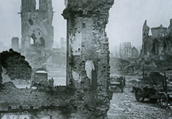HOME > Taisho Democracy : Outline
Outline
- a. Political Upheavals in the Taisho Era
- b. The First World War and Japan
- c. The Era of Party based Government

Crowd assembled before the House of Representatives gate, February 5, 1913 (Taisho 2). "Mede Miru Gikai Seiji 100nenshi"
The 2nd SAIONJI Cabinet was succeeded by the 3rd KATSURA Cabinet. The Cabinet was condemned both inside and outside the Diet for blurring the distinction between Court and Government, as KATSURA was serving as well as Emperor Taisho's Keeper of the Privy Seal and Grand Chamberlain. KATSURA tried to organize a new political party in opposition to the Movement to Protect the Constitution, but in the end, his Cabinet resigned en masse. Still, his plan to establish a new party finally bore fruit with the formation of the Association of Believers in Constitutional Government (Rikken Doshikai), paving the way for the later two party system of party cabinets.
The 1st YAMAMOTO Gonnohyoe put in place the system where by only military men in active service were allowed to become Army and Navy Ministers. The 1st YAMAMOTO Cabinet collapsed on account of the 1914 (Taisho 3) Siemens scandal. The 2nd OKUMA Cabinet followed with the support of the Genro, with the Rikken Doshikai serving as the ruling party.
Historical materials and Description
 3-1Request for Two Additional Army Divisions
3-1Request for Two Additional Army Divisions
- YAMAGATA Aritomo's Opinion Brief
- Letter from UEHARA Yusaku to KATSURA Taro
 3-2Rikken Doshikai ('Constitutioned Association of Friends')
3-2Rikken Doshikai ('Constitutioned Association of Friends')
- Draft of General Principles and Platform of the Rikken Doshikai
 3-3Formation of the 2nd OKUMA Shigenobu Cabinet
3-3Formation of the 2nd OKUMA Shigenobu Cabinet
- Account Summarizing the Meeting between Marquis INOUE and Count OKUMA

Ruined Ypres, Belgium after the World War I Taisho period. From "Document Showa Vol.1"
When the World War I broke out in 1914 (Taisho 3), the 2nd OKUMA Cabinet decided to enter the war against Germany using the Anglo-Japanese Alliance as justification. Japan, the following year, forced the so-called Twenty one Demands on China as a way to expand Japan's rights in that country. (and secure hegemony over it.) The closing doup of the war, witnessed rice hoarding related to the expedition of Japanese troops to Siberia, giving rise to the Rice Riots, greatly shocking Japan's leadership.
The Paris Peace Conference, was convened in 1919 (Taisho 8) and residted in the signing of the Treaty of Versailles in 1920 on the basis of which the League of Nations was established. The international security framework that followed was known as the 'Versailles system.' The postwar world order was further defined by various treaties, including the Washington Naval Treaty of 1922 (Taisho 11).
Historical materials and Description
 3-4World War Ⅰ and Japan
3-4World War Ⅰ and Japan
- Account of Prime Minister OKUMA's Meeting with Four Genro
 3-5Dispatch of Japanese Troops to Siberia
3-5Dispatch of Japanese Troops to Siberia
- Opinion Brief on the Dispatch of Troops to Siberia
 3-6Rice Riots ("Kome Sodo")
3-6Rice Riots ("Kome Sodo")
- 1918 (Taisho 7) Diary
 3-7Paris Peace Conference
3-7Paris Peace Conference
- Japan's Policy in Peace Conference
In 1918 (Taisho 7), HARA Takashi, the head of the Rikken Seiyukai, organized Japan's first "true" party Cabinet. The party splintered with HARA's assassination in 1921 (Taisho 10), and was followed by transition Cabinets. The formation of a so-called "transcendent" Cabinet by KIYOURA Keigo led to the 2nd Movement to Protect the Constitution. KATO Takaaki, head of the Kenseikai (Constitutional Government Association), then formed a coalition cabinet known as the Three-Factions Cabinet, made up of the Kenseikai, the Seiyukai, and the Kakushin Kurabu (Reform Club). In 1925 (Taisho 14), the Universal Manhood Suffrage Law took effect, after which the Seiyukai and Minseito, the latter of which was the successor to the Rikken Doshikai and the Kenseikai, alternated in controling the Government, heralding the beginning of the era of party cabinets.
Historical materials and Description
 3-8Commoner-and-minister
3-8Commoner-and-minister
- Political Daily, Vol. One
 3-9Movement for Universal Suffrage
3-9Movement for Universal Suffrage
- Resolution of the Nationwide Universal Manhood Suffrage Federation (Zenkoku Fusen Rengokai)
 3-10Assassination of Prime Minister HARA
3-10Assassination of Prime Minister HARA
- Telegram from MATSUMOTO Gokichi to HIRATA Tosuke
- Manuscript of Prime Minister's Inaugural Speech
 3-11Great Kanto Earthquake of 1923
3-11Great Kanto Earthquake of 1923
- Diary of 1923
 3-122nd Movement to Protect the Constitution
3-122nd Movement to Protect the Constitution
- Notes on the Establishment of the KIYOURA Cabinet
 3-13Adoption of Universal Manhood Suffrage Law and Peace Preservation Law
3-13Adoption of Universal Manhood Suffrage Law and Peace Preservation Law
- Draft of the three Factions' Committee's Decision on Universal Manhood Suffrage
- Decision of Cabinet on Peace Preservation Law
 3-14First Regular Election with Universal Manhood Suffrage
3-14First Regular Election with Universal Manhood Suffrage
- Gist of Speech Delivered at Rikken Minseito's Kansai Convention
- "Major Policies of the Seiyukai" (Tokyo Nichinichi Shinbun)
- rinciples and Charter of the Rikken Minseito Prior to the First Manhood Suffrage Election (Tokyo Nichinichi Shinbun)
- Election Guideline (Home Ministry)
- Election Poster
 3-15Emergence and Growth of Proletarian Political Parties
3-15Emergence and Growth of Proletarian Political Parties
- Measure and Report of the Japan Ronoto Party Headquarters, Presented at Its First National Convention
 3-16Formation of the HAMAGUCHI Cabinet
3-16Formation of the HAMAGUCHI Cabinet
- Diary of HAMAGUCHI Osachi
 3-17London Naval Conference
3-17London Naval Conference
- Full Account of Japan's Position at the London Conference
- SHIDEHARA Kijuro's Letter to MAKINO Nobuaki
- Kitsugai Shimatsu (A Memoir)
 3-18Shooting of Prime Minister HAMAGUCHI Osachi
3-18Shooting of Prime Minister HAMAGUCHI Osachi
- Daily Log of the 59th Diet Proceedings